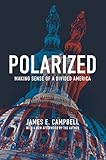Polarized : Making Sense of a Divided America / James E. Campbell.
Material type: TextPublisher: Princeton, NJ : Princeton University Press, [2018]Copyright date: ©2018Description: 1 online resource (336 p.) : 9 b/w illus., 23 tablesContent type:
TextPublisher: Princeton, NJ : Princeton University Press, [2018]Copyright date: ©2018Description: 1 online resource (336 p.) : 9 b/w illus., 23 tablesContent type: - 9780691180861
- 9781400889273
- Divided government -- United States
- Party affiliation -- United States
- Polarization (Social sciences) -- United States
- Political culture -- United States
- Political participation -- United States
- Political parties -- United States
- Right and left (Political science) -- United States
- POLITICAL SCIENCE / Political Process / Political Parties
- Activism
- Advocacy
- Americans
- Barack Obama
- Bipartisanship
- Bowdoin College
- CQ Press
- Calculation
- Centre-left politics
- Centre-right politics
- Centrism
- Circumstantial evidence
- Communism
- Conservative Democrat
- Conservative Party (UK)
- Counterculture
- Culture war
- Dealignment
- Determination
- Donald Trump
- Dummy variable (statistics)
- Election
- Electoral College (United States)
- Exit poll
- Extremism
- Far-right politics
- General election
- George W. Bush
- Government
- Graduate school
- Hillary Clinton
- Hippie
- Ideology
- Incumbent
- John McCain
- Larry Sabato
- Left-wing politics
- Legislation
- Liberal conservatism
- Liberalism
- Louisiana State University
- Macropartisanship
- Major party
- Majority
- Measurement
- Median voter theorem
- Midterm election
- Minor party
- Moderate
- Multi-party system
- National Science Foundation
- National security
- New Deal coalition
- Newt Gingrich
- Nomination contest
- Nomination
- Norman Ornstein
- Observational error
- Obstacle
- On the Issues
- Opposition Party
- Party discipline
- Party identification
- Party leader
- Party system
- Percentage point
- Percentage
- Political campaign
- Political party
- Political philosophy
- Political spectrum
- Politician
- Politics of the United States
- Politics
- Public opinion
- Public policy
- Realigning election
- Rebuttal
- Republican Party (United States)
- Respondent
- Right-wing politics
- Rockefeller Republican
- Ronald Reagan
- Social issue
- Split-ticket voting
- Standard deviation
- Syracuse University
- Tax
- The American Voter
- The Federalist Papers
- The Public Interest
- Tom Mann
- Two-party system
- Unemployment
- Voter turnout
- Voting
- Walter Lippmann
- What Happened
- World War II
- Writing
- 320.97309/051 23
- JK1726 .C359 2018
- online - DeGruyter
| Item type | Current library | Call number | URL | Status | Notes | Barcode | |
|---|---|---|---|---|---|---|---|
 eBook
eBook
|
Biblioteca "Angelicum" Pont. Univ. S.Tommaso d'Aquino Nuvola online | online - DeGruyter (Browse shelf(Opens below)) | Online access | Not for loan (Accesso limitato) | Accesso per gli utenti autorizzati / Access for authorized users | (dgr)9781400889273 |
Frontmatter -- CONTENTS -- FIGURES AND TABLES -- Acknowledgments -- Introduction -- Part One. Preparing the Foundation -- Chapter 1. Knowns and Unknowns -- Chapter 2. History and Theories -- Part Two. The Polarized Electorate -- Chapter 3. Ideology and Polarization -- Chapter 4. Issues and Polarization -- Chapter 5. Circumstantial Evidence -- Part Three. The Polarized Parties -- Chapter 6. Why Are the Parties More Polarized? -- Chapter 7. One- Sided Party Polarization? -- Chapter 8. Why Are the Parties Polarized at All? -- Chapter 9. Polarization and Democracy -- Afterword -- Appendix A. Five Ideological Series -- Appendix B. Regression Analyses of Ideological Orientations -- Notes -- References -- Index
restricted access online access with authorization star
http://purl.org/coar/access_right/c_16ec
Many continue to believe that the United States is a nation of political moderates. In fact, it is a nation divided. It has been so for some time and has grown more so. This book provides a new and historically grounded perspective on the polarization of America, systematically documenting how and why it happened.Polarized presents commonsense benchmarks to measure polarization, draws data from a wide range of historical sources, and carefully assesses the quality of the evidence. Through an innovative and insightful use of circumstantial evidence, it provides a much-needed reality check to claims about polarization. This rigorous yet engaging and accessible book examines how polarization displaced pluralism and how this affected American democracy and civil society.Polarized challenges the widely held belief that polarization is the product of party and media elites, revealing instead how the American public in the 1960s set in motion the increase of polarization. American politics became highly polarized from the bottom up, not the top down, and this began much earlier than often thought. The Democrats and the Republicans are now ideologically distant from each other and about equally distant from the political center. Polarized also explains why the parties are polarized at all, despite their battle for the decisive median voter. No subject is more central to understanding American politics than political polarization, and no other book offers a more in-depth and comprehensive analysis of the subject than this one.
Mode of access: Internet via World Wide Web.
In English.
Description based on online resource; title from PDF title page (publisher's Web site, viewed 29. Jun 2022)


